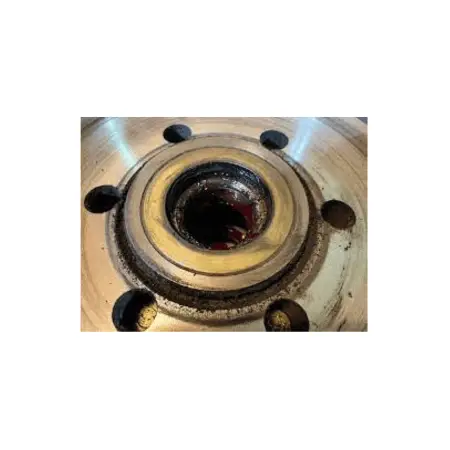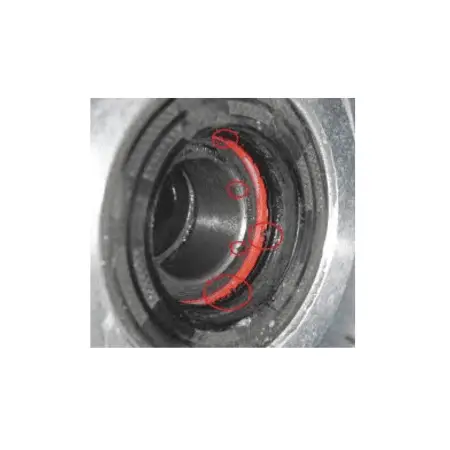Wheel bearing seals are a crucial component of any vehicle’s wheel assembly. They play a significant role in keeping contaminants out and lubricants in, ensuring smooth and efficient operation of the wheel bearings. In this article, we will explore what should wheel bearing seals be checked for in detail. So keep on reading…
What should wheel bearing seals be checked for? When checking wheel bearing seals, look for any cracks, tears, or breaks in the seals, which could let dirt and water in and damage the bearings. Make sure the seals fit snugly around the bearings with no gaps or looseness, and check that they’re still flexible and not stiff or brittle. Look for any leaks around the seals, like grease or oil residue, which could mean the seals aren’t keeping the lubricant inside properly. Also, inspect for any signs of corrosion or rust around the seals, which could weaken them and make them less effective at keeping out contaminants.

Signs of Faulty Wheel Bearing Seals
Signs of faulty wheel bearing seals include:
Grease or Oil Leakage: If you notice grease or oil leaking from around the wheel bearing area, it could be a sign that the seals are damaged or worn out, allowing lubricant to escape.
Strange Noises: Faulty wheel bearing seals can cause unusual noises, such as grinding, rumbling, or humming, especially when driving at higher speeds. These noises may indicate that the wheel bearings are not properly lubricated due to seal failure.
Uneven Tire Wear: When wheel bearing seals fail, it can lead to uneven tire wear. This is because improper lubrication or contamination of the wheel bearings can cause them to wear out unevenly, affecting the alignment and balance of the tires.
Wheel Wobble or Vibration: A wobbling sensation or vibration felt through the steering wheel or vehicle chassis, particularly at certain speeds, can be a sign of wheel bearing seal issues. This can occur due to uneven wear or damage to the wheel bearings caused by inadequate sealing.
Excessive Heat: Faulty wheel bearing seals can lead to excessive heat buildup in the wheel assembly due to friction from lack of proper lubrication. If you notice hot or overheated wheel hubs after driving, it could indicate a problem with the seals.
ABS Warning Light: In vehicles equipped with an Anti-lock Braking System (ABS), a faulty wheel bearing seal may trigger the ABS warning light on the dashboard. This happens when the ABS sensor detects irregularities in wheel speed caused by compromised wheel bearings.
If you experience any of these signs, it’s essential to have your vehicle inspected by a qualified mechanic to diagnose and address any potential issues with the wheel bearing seals promptly. Ignoring faulty seals can lead to further damage to the wheel bearings and compromise the safety and performance of your vehicle.

Common issues with wheel bearing seals
Leakage: One of the most frequent problems is when the seals fail to contain the lubricating grease within the wheel bearings. This can lead to grease leaking out of the seal, which not only causes messy buildup but also reduces the effectiveness of the lubrication, potentially resulting in premature wear of the bearings.
Damage: Wheel bearing seals can suffer damage from various sources, such as road debris, impacts, or improper installation. Cracks, tears, or breaks in the seals can allow contaminants like dirt, water, or grit to infiltrate the bearings, leading to accelerated wear and potential failure.
Wear and Tear: Over time, wheel bearing seals can experience wear and tear, becoming less effective at forming a tight seal around the bearings. This can result in decreased protection against contaminants and lubricant leakage.
Corrosion: Exposure to moisture and road salt can cause corrosion or rust to develop around the seals, weakening their integrity and compromising their ability to keep out contaminants.
Improper Installation: Incorrect installation of wheel bearing seals, such as not seating them properly or using damaged seals, can lead to immediate issues or premature failure. It’s essential to follow manufacturer recommendations and ensure proper installation procedures are followed to avoid potential problems.
By being aware of these common issues and regularly inspecting wheel bearing seals, you can address any problems early and maintain the optimal performance and longevity of your vehicle’s wheel bearings.
you may find helpful
- How To Know If Blend Door Actuator Is Bad? Signs & Dignoses
- Why My Car Won’t Accelerate But RPMs Go Up? Explained
- Why All My Gauges Stopped Working While Driving & What To Do?
- Airbag Light Comes On And Off While Driving – Reasons & Solutions

When to Replace Wheel Bearing Seals
Visible Damage: Wheel bearing seals can become damaged due to various factors like road debris, impacts, or wear over time. If you see any visible signs of damage such as cracks, tears, or breaks in the seals, it’s a clear indication that they need to be replaced. Damaged seals can allow contaminants like dirt and water to enter the wheel bearings, leading to potential damage and reduced performance.
Leakage: Wheel bearing seals are designed to keep the lubricating grease or oil inside the wheel bearings. If you notice any grease or oil leaking from around the wheel bearing area, it’s a sign that the seals have failed and are no longer effectively containing the lubricant. This can result in inadequate lubrication of the bearings, leading to premature wear and potential failure.
Strange Noises: Faulty wheel bearing seals can cause abnormal noises such as grinding, rumbling, or humming, especially when driving at higher speeds. These noises may indicate that the wheel bearings are not receiving proper lubrication due to seal failure. Ignoring these noises can lead to further damage to the bearings and compromise the safety of the vehicle.
Uneven Tire Wear: Wheel bearing seal issues can also manifest as uneven tire wear. When the wheel bearings are not properly lubricated due to seal failure, it can result in uneven wear patterns on the tires. This can affect the handling and stability of the vehicle and may indicate the need for seal replacement.
Wheel Wobble or Vibration: A wobbling sensation or vibration felt through the steering wheel or vehicle chassis, especially at certain speeds, can be a sign of wheel bearing seal problems. When the wheel bearings are compromised due to inadequate sealing, it can lead to instability and vibrations while driving.
Excessive Heat: Wheel bearing seal failure can cause excessive heat buildup in the wheel assembly due to friction from lack of proper lubrication. If you notice hot or overheated wheel hubs after driving, it could be a sign of seal issues and the need for replacement to prevent further damage.
Steps for Replacement:
- Jack up the Vehicle: To begin the replacement process, safely lift the vehicle using a jack and secure it on jack stands to ensure stability and safety while working underneath.
- Remove the Wheel: Once the vehicle is securely lifted, remove the wheel to access the wheel hub and bearings. This may require loosening and removing the lug nuts using a lug wrench.
- Inspect the Seals: With the wheel removed, inspect the condition of the existing seals for any signs of damage, wear, or leakage.
- Remove the Old Seals: If replacement is necessary, use appropriate tools such as seal pullers or pry bars to carefully remove the old seals from the wheel hub. Take care not to damage the hub or bearings during this process.
- Clean the Area: After removing the old seals, thoroughly clean the wheel hub and bearings using a suitable solvent or degreaser to remove any dirt, grease, or debris that may have accumulated.
- Install the New Seals: Carefully install the new wheel bearing seals into the designated seating area on the wheel hub, ensuring they are properly aligned and seated securely. Use a seal installation tool or a soft mallet to tap the seals into place gently.
- Reassemble the Wheel: Once the new seals are installed, reassemble the wheel by placing it back onto the wheel hub and tightening the lug nuts to the manufacturer’s specified torque settings using a torque wrench.
- Lower the Vehicle: After reassembly, carefully lower the vehicle from the jack stands and ensure it is on stable ground before continuing.
- Test Drive: Before completing the replacement process, take the vehicle for a test drive to ensure everything is functioning correctly and there are no abnormal noises, vibrations, or handling issues. This allows you to verify that the new seals are effectively sealing the wheel bearings and providing proper lubrication.
By following these steps for replacement and being vigilant for signs of seal failure, you can help maintain the integrity and performance of the wheel bearings in your vehicle, ensuring safe and reliable operation on the road.
Conclusion
Wheel bearing seals are critical components of any vehicle’s wheel assembly, responsible for keeping contaminants out and lubricants in. Regular inspection and maintenance of these seals are essential to ensure smooth and efficient operation, prevent costly repairs, and ensure vehicle safety.
F.A.Qs
Damaged wheel bearing seals typically need to be replaced rather than repaired. Once a seal is damaged, such as by cracks, tears, or breaks, it’s difficult to effectively repair it to maintain its original integrity and function. Additionally, attempting to repair a damaged seal may not provide a reliable long-term solution, as it may still allow contaminants to enter the wheel bearings, leading to further damage and potential safety risks.
Driving with faulty wheel bearing seals can lead to premature wear and failure of the wheel bearings, resulting in unusual noises, reduced performance, and safety risks such as vibrations and uneven tire wear. Ignoring seal issues can ultimately lead to loss of vehicle control and accidents.
To extend the lifespan of your wheel bearing seals, prioritize regular maintenance checks to detect any signs of damage early, keep the seals clean to prevent debris buildup, and avoid driving in harsh conditions like deep water or extreme off-road terrain. Ensure proper installation of the seals and use high-quality replacement parts when needed.
